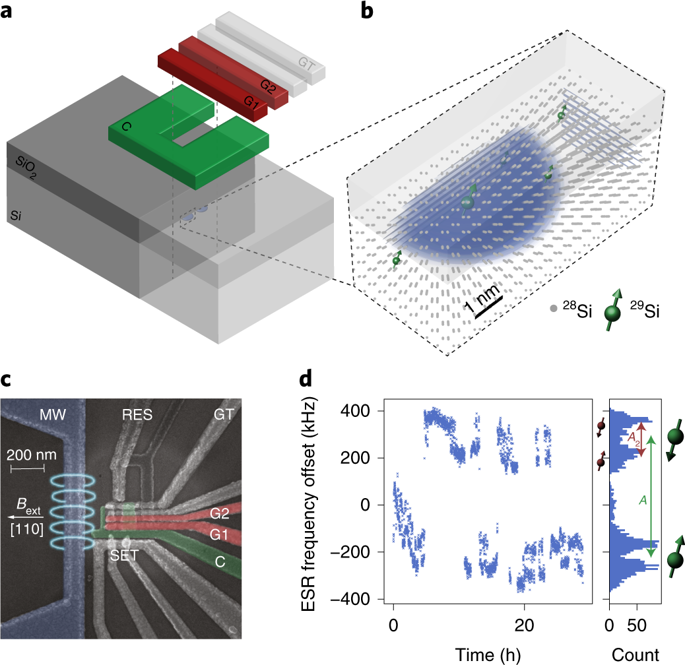当前位置:
X-MOL 学术
›
Nat. Nanotechnol.
›
论文详情
Our official English website, www.x-mol.net, welcomes your
feedback! (Note: you will need to create a separate account there.)
A silicon quantum-dot-coupled nuclear spin qubit.
Nature Nanotechnology ( IF 38.1 ) Pub Date : 2019-12-09 , DOI: 10.1038/s41565-019-0587-7 Bas Hensen 1, 2 , Wister Wei Huang 1 , Chih-Hwan Yang 1 , Kok Wai Chan 1 , Jun Yoneda 1 , Tuomo Tanttu 1 , Fay E Hudson 1 , Arne Laucht 1 , Kohei M Itoh 3 , Thaddeus D Ladd 4 , Andrea Morello 1 , Andrew S Dzurak 1
Nature Nanotechnology ( IF 38.1 ) Pub Date : 2019-12-09 , DOI: 10.1038/s41565-019-0587-7 Bas Hensen 1, 2 , Wister Wei Huang 1 , Chih-Hwan Yang 1 , Kok Wai Chan 1 , Jun Yoneda 1 , Tuomo Tanttu 1 , Fay E Hudson 1 , Arne Laucht 1 , Kohei M Itoh 3 , Thaddeus D Ladd 4 , Andrea Morello 1 , Andrew S Dzurak 1
Affiliation

|
Single nuclear spins in the solid state are a potential future platform for quantum computing1-3, because they possess long coherence times4-6 and offer excellent controllability7. Measurements can be performed via localized electrons, such as those in single atom dopants8,9 or crystal defects10-12. However, establishing long-range interactions between multiple dopants or defects is challenging13,14. Conversely, in lithographically defined quantum dots, tunable interdot electron tunnelling allows direct coupling of electron spin-based qubits in neighbouring dots15-20. Moreover, the compatibility with semiconductor fabrication techniques21 may allow for scaling to large numbers of qubits in the future. Unfortunately, hyperfine interactions are typically too weak to address single nuclei. Here we show that for electrons in silicon metal-oxide-semiconductor quantum dots the hyperfine interaction is sufficient to initialize, read out and control single 29Si nuclear spins. This approach combines the long coherence times of nuclear spins with the flexibility and scalability of quantum dot systems. We demonstrate high-fidelity projective readout and control of the nuclear spin qubit, as well as entanglement between the nuclear and electron spins. Crucially, we find that both the nuclear spin and electron spin retain their coherence while moving the electron between quantum dots. Hence we envision long-range nuclear-nuclear entanglement via electron shuttling3. Our results establish nuclear spins in quantum dots as a powerful new resource for quantum processing.
中文翻译:

硅量子点耦合核自旋量子位。
固态中的单核自旋是未来量子计算的潜在平台 1-3,因为它们具有较长的相干时间 4-6 并提供出色的可控性 7。可以通过局部电子进行测量,例如单原子掺杂剂 8,9 或晶体缺陷 10-12 中的电子。然而,在多种掺杂剂或缺陷之间建立长程相互作用具有挑战性13,14。相反,在光刻定义的量子点中,可调谐点间电子隧穿允许在相邻点中直接耦合基于电子自旋的量子位 15-20。此外,与半导体制造技术的兼容性可能允许在未来扩展到大量的量子位。不幸的是,超精细相互作用通常太弱而无法解决单核问题。在这里,我们表明,对于硅金属-氧化物-半导体量子点中的电子,超精细相互作用足以初始化、读出和控制单个 29Si 核自旋。这种方法将核自旋的长相干时间与量子点系统的灵活性和可扩展性相结合。我们展示了核自旋量子位的高保真投影读出和控制,以及核自旋和电子自旋之间的纠缠。至关重要的是,我们发现核自旋和电子自旋在量子点之间移动电子时都保持其相干性。因此,我们设想通过电子穿梭进行远程核-核纠缠3。我们的结果将量子点中的核自旋确立为一种强大的量子处理新资源。读出并控制单个 29Si 核自旋。这种方法将核自旋的长相干时间与量子点系统的灵活性和可扩展性相结合。我们展示了核自旋量子位的高保真投影读出和控制,以及核自旋和电子自旋之间的纠缠。至关重要的是,我们发现核自旋和电子自旋在量子点之间移动电子时都保持其相干性。因此,我们设想通过电子穿梭进行远程核-核纠缠3。我们的结果将量子点中的核自旋确立为一种强大的量子处理新资源。读出并控制单个 29Si 核自旋。这种方法将核自旋的长相干时间与量子点系统的灵活性和可扩展性相结合。我们展示了核自旋量子位的高保真投影读出和控制,以及核自旋和电子自旋之间的纠缠。至关重要的是,我们发现核自旋和电子自旋在量子点之间移动电子时都保持其相干性。因此,我们设想通过电子穿梭进行远程核-核纠缠3。我们的结果将量子点中的核自旋确立为一种强大的量子处理新资源。我们展示了核自旋量子位的高保真投影读出和控制,以及核自旋和电子自旋之间的纠缠。至关重要的是,我们发现核自旋和电子自旋在量子点之间移动电子时都保持其相干性。因此,我们设想通过电子穿梭进行远程核-核纠缠3。我们的结果将量子点中的核自旋确立为一种强大的量子处理新资源。我们展示了核自旋量子位的高保真投影读出和控制,以及核自旋和电子自旋之间的纠缠。至关重要的是,我们发现核自旋和电子自旋在电子在量子点之间移动时都保持其相干性。因此,我们设想通过电子穿梭进行远程核-核纠缠3。我们的结果将量子点中的核自旋确立为一种强大的量子处理新资源。
更新日期:2019-12-11
中文翻译:

硅量子点耦合核自旋量子位。
固态中的单核自旋是未来量子计算的潜在平台 1-3,因为它们具有较长的相干时间 4-6 并提供出色的可控性 7。可以通过局部电子进行测量,例如单原子掺杂剂 8,9 或晶体缺陷 10-12 中的电子。然而,在多种掺杂剂或缺陷之间建立长程相互作用具有挑战性13,14。相反,在光刻定义的量子点中,可调谐点间电子隧穿允许在相邻点中直接耦合基于电子自旋的量子位 15-20。此外,与半导体制造技术的兼容性可能允许在未来扩展到大量的量子位。不幸的是,超精细相互作用通常太弱而无法解决单核问题。在这里,我们表明,对于硅金属-氧化物-半导体量子点中的电子,超精细相互作用足以初始化、读出和控制单个 29Si 核自旋。这种方法将核自旋的长相干时间与量子点系统的灵活性和可扩展性相结合。我们展示了核自旋量子位的高保真投影读出和控制,以及核自旋和电子自旋之间的纠缠。至关重要的是,我们发现核自旋和电子自旋在量子点之间移动电子时都保持其相干性。因此,我们设想通过电子穿梭进行远程核-核纠缠3。我们的结果将量子点中的核自旋确立为一种强大的量子处理新资源。读出并控制单个 29Si 核自旋。这种方法将核自旋的长相干时间与量子点系统的灵活性和可扩展性相结合。我们展示了核自旋量子位的高保真投影读出和控制,以及核自旋和电子自旋之间的纠缠。至关重要的是,我们发现核自旋和电子自旋在量子点之间移动电子时都保持其相干性。因此,我们设想通过电子穿梭进行远程核-核纠缠3。我们的结果将量子点中的核自旋确立为一种强大的量子处理新资源。读出并控制单个 29Si 核自旋。这种方法将核自旋的长相干时间与量子点系统的灵活性和可扩展性相结合。我们展示了核自旋量子位的高保真投影读出和控制,以及核自旋和电子自旋之间的纠缠。至关重要的是,我们发现核自旋和电子自旋在量子点之间移动电子时都保持其相干性。因此,我们设想通过电子穿梭进行远程核-核纠缠3。我们的结果将量子点中的核自旋确立为一种强大的量子处理新资源。我们展示了核自旋量子位的高保真投影读出和控制,以及核自旋和电子自旋之间的纠缠。至关重要的是,我们发现核自旋和电子自旋在量子点之间移动电子时都保持其相干性。因此,我们设想通过电子穿梭进行远程核-核纠缠3。我们的结果将量子点中的核自旋确立为一种强大的量子处理新资源。我们展示了核自旋量子位的高保真投影读出和控制,以及核自旋和电子自旋之间的纠缠。至关重要的是,我们发现核自旋和电子自旋在电子在量子点之间移动时都保持其相干性。因此,我们设想通过电子穿梭进行远程核-核纠缠3。我们的结果将量子点中的核自旋确立为一种强大的量子处理新资源。











































 京公网安备 11010802027423号
京公网安备 11010802027423号